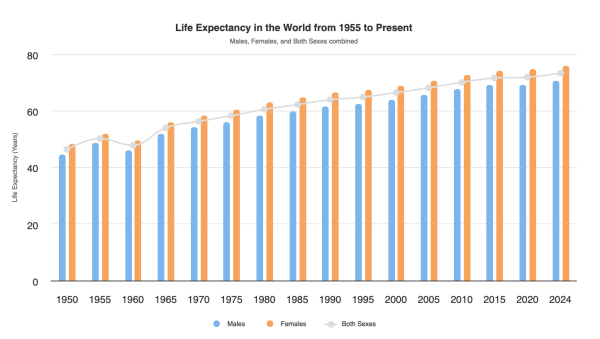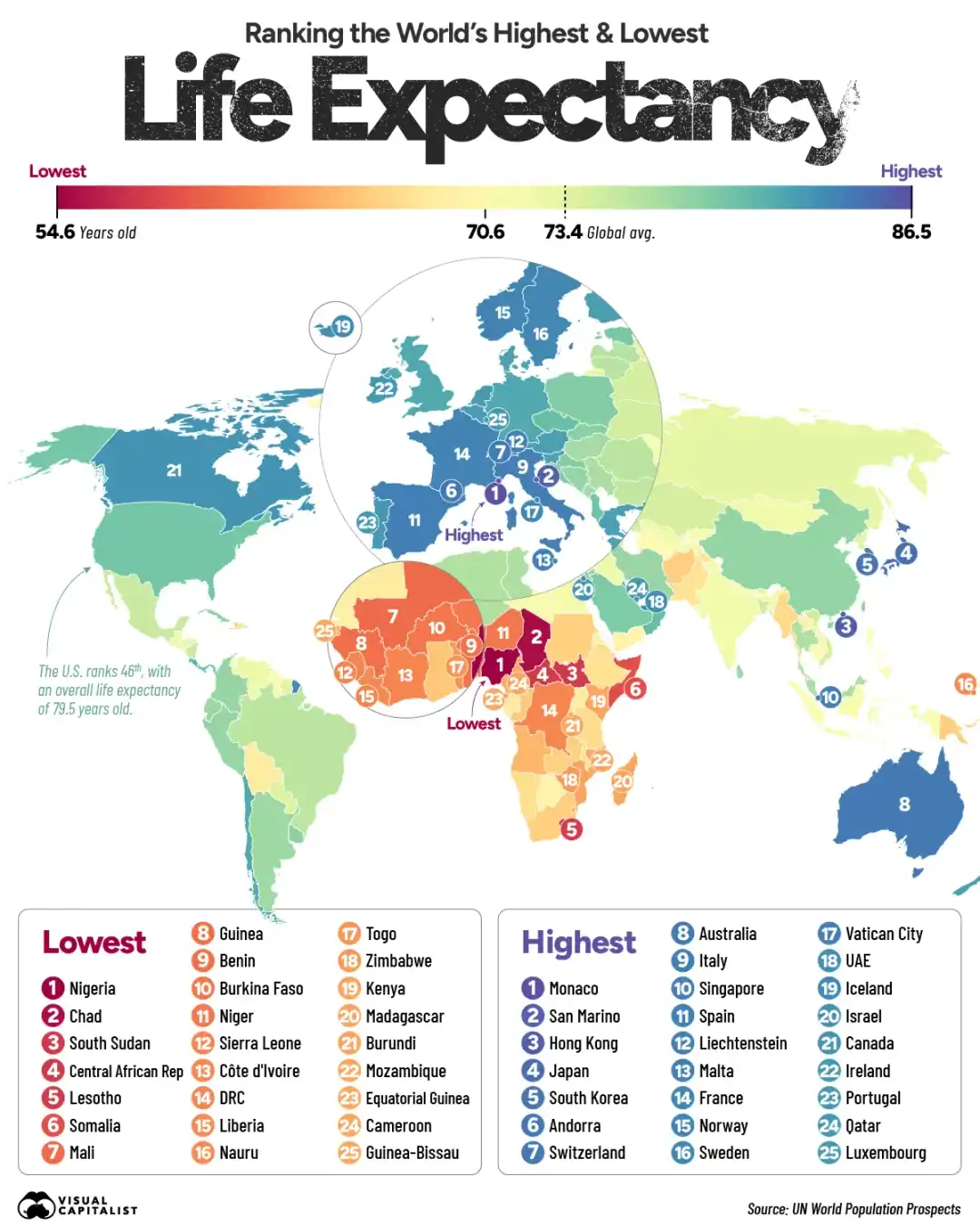In writing these articles and newsletters, I often try to alternate between optimism, pragmatism, and an acknowledgement of where progress might still fall short.
An Area of Boundless Optimism, Grounded In Progress
Health and longevity and things almost every human strives for. As a result, medicine isn’t just a field — it’s a quest. With every breakthrough, we rewrite the boundaries of what’s possible. Today, optimism is more than wishful thinking … it’s anchored in real, measurable progress.
The Steady Rise of Lifespan Worldwide
Life expectancy has been on a steady global rise for a long time. Global life expectancy has risen by nearly 20 years since 1950. As of 2023, average life expectancy is estimated at 76.3 years for women and 71.5 for men, returning to pre-pandemic levels after COVID-related dips.

via worldometers
Life expectancy depends on many factors. While genetics lay the foundation, access to healthcare, quality nutrition, reliable infrastructure, and income levels shape how long — and how well — people live. Here is an infographic showing expected lifespans across the globe.

via VisualCapitalist.
Meanwhile, global health continues to make progress. For example, age-standardized mortality rates have dropped by 66.6% worldwide from 1950–2023, even as the overall number of deaths rose due to population growth and aging.
Breakthroughs in Medicine
I am astounded by the pace of progress in diagnostics, imaging, treatments, cures, and now even regenerative medicine.
Examples abound. When I was growing up, if an athlete had an ACL injury, it almost certainly meant their career was over. Today, even after three ACL repairs, my son continues to play rugby competively.
In addition, my son’s ACL surgery scars are smaller than his knee, I remember when they had to slice you open, and peel your skin back just to perform that surgery. Even my mom’s knee replacement was easier, with less scarring, and less immuno-rejection that before.
But that’s only the tip of the iceberg.
You don‘t have to be an athlete to desire the ability to continue to do what you want to do for longer. Extending not just lifespan but healthspan — the years spent active and well — is medicine’s true measure of success.
Emerging Technologies Are Changing What’s Possible
Growing up, I remember when medicine first began using lasers, or when the world witnessed the first successful human heart transplant. I remember when antiretroviral therapy transformed HIV/AIDS from a death sentence into a manageable condition.
Now, advancements like these are happening in years or months, not decades.
For example, Gene therapy adoption is growing, and so is its impact. The number of patients treated with gene therapies in the U.S. is expected to grow from 16,000 in 2020 to about 95,000 in 2025. By the end of 2034, over 1 million patients may have been treated, with an average quality-adjusted life expectancy gain of 5.12 years per recipient.
Even the rise of Semaglutide and Tirzepatide represents an amazing transformation in medicine science. They change appetite signaling and satiety, showing that pharmacology can now reliably alter the biology of hunger in ways researchers once thought impossible. And, while it’s great for weight loss, it’s also incredible for diabetes care.
From gene therapy to early detection of Alzheimer’s, AI-enhanced cancer diagnostics, and even preliminary treatments (not just symptom management) for Huntington’s disease and AIDS — the world is changing for the better. And the effects are global. Thanks to rapid innovation, affordable treatments for conditions like malaria are reaching communities that were once out of reach.
Forecasting The Road Ahead
- Personalized medicine will be mainstream —treatments tailored to genetic profiles, lifestyles, and early diagnostics, reducing trial-and-error therapies.
- AI-driven preventive care will spot risks and recommend actions before symptoms arise, changing “medicine” from reactive to proactive.
- Expect radical decentralization — healthcare delivered everywhere, not just in clinics, with patient data guiding choices in real time.
- It’s a ‘Journey’ not a ‘Destination’: Medicine is like a city’s traffic system—treating one bottleneck may shift or reveal another. Life expectancy gains require coordination (genetics, public health, tech, economy) to avoid congestion in vulnerable areas.
- Longevity Risks: Like a pebble dropped into a pond, each breakthrough creates ripples of unexpected effects — longer lives mean new societal needs, workforce changes, and shifting cultural attitudes toward aging. Longer lives will bring promises and perils we’re only beginning to see.
- Hype vs. Evidence: Not all breakthroughs deliver widespread impact; many promising treatments prove costly, ineffective, or even harmful at scale.
Conclusion
In a world obsessed with headlines about division and setbacks, medicine offers something different: hope grounded in evidence.
We’re not only adding years to life but adding life to years—making more moments meaningful for more people, everywhere.
The promise of a healthier future doesn’t come from wishful thinking. It comes from pragmatic optimism — acknowledging the challenges, investing in innovation, and daring to imagine what’s next.
That’s a future worth working toward.
Onwards!

Leave a Reply